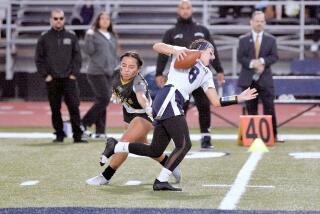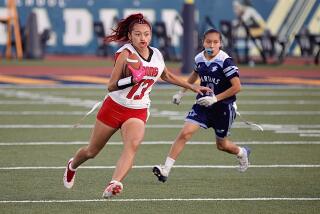Front-Window Tinting Is Banned for Safety Reasons
- Share via
Dear Street Smart: I thought tinted windows were illegal. Every week, it seems, I get into a waiting game at a four-way stop with someone driving the van from “E.T.” I have no way of telling what the driver might be signaling, because I can’t see into the car--it’s like looking into Darth Vader’s helmet. For all I know, the driver is buck naked and asleep. Isn’t that illegal? Tinted front windows, I mean, not driving nude.
D.R. Peck
Laguna Beach
Indeed it is, according to Steve Kohler, a spokesman for the California Highway Patrol. Any tinting, other than that which comes standard from the factory, is strictly illegal on a car’s front windshield or either front side window. The primary reason for the prohibition, he said, is safety.
“You probably wouldn’t wear your sunglasses if you drove at night,” Kohler said, “yet if you apply this material to your windshield, that, in effect, is what you are doing. It cuts down on visibility for the driver and in a situation where visibility is already limited, you don’t want to limit it further.”
Windows tinted at the factory, he said, are usually lighter than those tinted later. In addition, he said, commercially tinted windows can be spotted because the tint is on the surface of the glass rather than inside it. Often, Kohler said, drivers with tinted windows come from other states--usually in the Heat Belt--where such tinting is allowed. “Sometimes they’re upset that we would cite them,” he said, “but if we were in their state we would have to obey their laws.”
As for driving nude, he quipped, “check your local ordinances. If you’re taking a shortcut through a nudist colony, it’s probably legal.”
Dear Street Smart:
Recently an “improvement” was made at Laguna Canyon and El Toro roads. The improvement eliminated a second northbound lane on Laguna Canyon Road used by drivers turning right from El Toro Road onto Laguna Canyon Road. The elimination of this lane apparently was done in order to create a left-turn lane for cars going in the opposite direction on Laguna Canyon Road, which is not wide enough there to accommodate two lanes in each direction at the intersection with El Toro Road.
This improvement doesn’t appear to have been well studied, was done in haste or, perhaps, in preparation for further improvements. The bottleneck on El Toro Road, turning right, is now much greater and any increase in traffic flow through the signal into Laguna appears to be negligible. Are there any future improvements destined for this enhanced problem, or could this improvement be improved by “disimproving” it?
Bert G. Fenenga
Aliso Viejo
Don’t hold your breath, says Terry Brandt, Laguna Beach’s director of municipal services. In fact, he said, the recent improvement has greatly enhanced the flow of traffic into Laguna Beach along Laguna Canyon Road. The change was a trade-off, he said, aimed at eliminating the longstanding problem of afternoon peak-hour traffic in that direction that sometimes backed up for miles. The situation was caused by the line of cars waiting to turn left onto El Toro Road without the benefit of a left-turn lane. By adding such a lane, Brandt said, the flow of traffic into town has been greatly increased.
But the only way to add the left-turn lane on the southbound side, he said, was to eliminate one of the two northbound lanes, thus forcing motorists to wait in line for right turns onto Laguna Canyon Road from El Toro Road. City officials opted for the change, Brandt said, as the greatest good for the greatest number.
“There are trade-offs,” he said, “and what we’re trying to do is help the largest number of people and we think the largest number of people are traveling inbound” to Laguna.
As for future improvements aimed at rectifying the inequity, he said, nothing is likely to happen soon.
The city, county and state are studying a proposal to significantly widen Laguna Canyon Road, a project that would improve the intersection in question, making it much easier to pass or turn in any direction. But at best, Brandt said, the proposal is still several years from realization.
Dear Street Smart:
My letter regards the intersection of La Palma and Tustin avenues in Anaheim. The traffic lights at this intersection appear to be controlled by a timer. The lights go through their timed cycles regardless of the traffic flow, so that in some cases the light for a direction of travel will turn green and stay that way for a long time even if no traffic is going in the direction of the light. If you come up to the signal just as it turns red, you will have to wait two to three minutes as the lights go through their timed cycles, even if little or no traffic is flowing against you.
My question is, why aren’t road sensors used to speed up the traffic-light cycles when no traffic is present for a particular green light?
David Grassmann
Brea
Not to worry, says John Lower, traffic and transportation manager for the city of Anaheim, the problem’s being taken care of. During a recent intersection-widening project, he confirmed, the lights in question were indeed operating on timers. But the project’s been completed, Lower said, and the signals are once again sensor-activated.
“We sent a traffic signal technician out there to check,” he said, “and everything’s operating fine.”
More to Read
Sign up for Essential California
The most important California stories and recommendations in your inbox every morning.
You may occasionally receive promotional content from the Los Angeles Times.













